Sean Quinn - the fall of Ireland's richest man
- Published
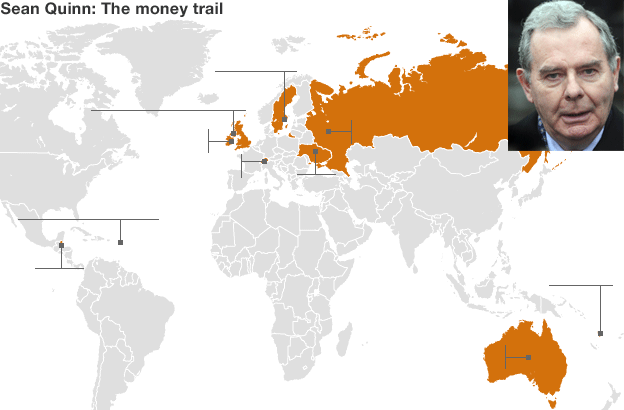 Moscow
Stockholm
County Fermanagh, NI
Dublin
Switzerland
Kiev
British Virgin Islands
Belize
Vanuatu
Australia
Moscow
Stockholm
County Fermanagh, NI
Dublin
Switzerland
Kiev
British Virgin Islands
Belize
Vanuatu
Australia
Moscow

The Kutuzoff tower block generates an estimated £14m ($22m) a year in rent and it should have been the Anglo Irish bank's biggest payback. Again, it had been signed away into a network of companies.
Stockholm
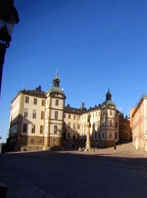
A secret boardroom coup allowed the Quinn family to take control of the company and move assets that had been used as security for loans from the Anglo Irish Bank out of the reach of the bank.
Derrylin, County Fermanagh
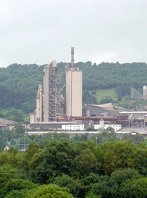
Sean Quinn started in business on his family farm with a £100 ($150) loan to extract gravel. He expanded into manufacturing, insurance and property, becoming a billionaire in the process.
Dublin
Sean Quinn was declared bankrupt in the Irish Republic, owing £2bn ($3bn) to the then Anglo Irish Bank. The bank was taken over by the state and its only role now is to recover money for the Irish taxpayer.
Switzerland
A Quinn family trust was set up in Switzerland at the same time as the Belize shell companies were being bought.
Kiev
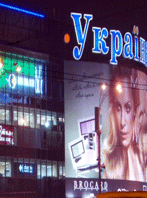
One of Quinn's biggest property assets was a large shopping mall generating £600,000 ($1m) a month. The bank was locked out and the mall was signed away into a network of companies.
British Virgin Islands
Cash from Ukraine passed through at least one company claiming to be owed money by the Quinn-owned property empire.
Belize
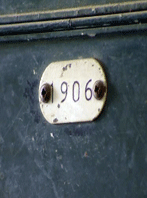
Much of the missing money, including �100m ($157m) to a single company, went to a series of shell companies here. The registered addresses of the companies were this postbox.
Vanuatu
The South Pacific island became a target in the search for Sean Quinn's missing millions after investigations in Australia. Vanuatu specialises in off-shore banking and offers strict secrecy and no taxes for investors.
Australia
Investigators from the Irish Banking Resolution Corporation flew to Sydney and Melbourne in search of £400m ($600m) of Sean Quinn's disappearing millions.
At the height of his success, Sean Quinn was the 12th richest man in the UK and the richest in Ireland.
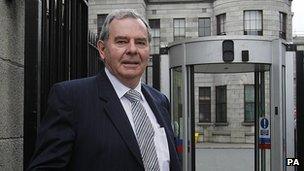
Sean Quinn, once the richest man in Ireland, has been found guilty of contempt of court
In the Sunday Times Rich List of 2007 he was just one place behind Sir Richard Branson and several above Bernie Ecclestone, with an estimated family fortune of £3.05 billion.
In December last year, he walked into a Belfast courtroom and declared himself bankrupt. He owed the bank more than £2bn. He now topped a new list - he was the biggest bankrupt in UK history.
But the bank that picked up his debts, the Irish state-owned IBRC, challenged his right to bankruptcy in the UK and successfully fought to transfer him to the jurisdiction of courts in the Irish Republic.
That's because the bank was already fighting Sean Quinn, and his family, for the recovery of hundreds of millions of pounds worth of assets.
The bank had taken charge of the Quinn empire in April 2011.
The insurance division was sold off but with the Irish taxpayer funding a financial black hole in its accounts that could cost £800m.
'De-Quinning'
The manufacturing division, which employs thousands in the border counties of Fermanagh and Cavan making building products, had its debts restructured but even if it too is sold, the Irish taxpayer will not see any return.
The only hope for the bank of recovering some of the billions owed lies in a vast portfolio of international property.
The property - in Ukraine, Russia and India - is worth around £400m. But since taking over, the bank has found itself literally locked out of the properties and rent to the tune of £20m has gone missing.
When it took control last year, the bank ousted all the senior Quinn family members and senior executives on day one.
The process was called "de-Quinning" by locals and provoked a violent backlash by some - with premises and company property being attacked.
However, it soon became clear that the bank's control over the group was not as comprehensive as it thought.
'Secret coup'
The international property had always been controlled by a Swedish holding company. But a number of weeks after taking charge, an invoice from Swedish lawyers which arrived at company headquarters alerted the bank to what appeared to be moves by the Quinn family to move the valuable property assets beyond its reach.
In a secret boardroom coup, Sean Quinn had been reinstalled as head of group property operations in Stockholm and had begun signing away rights to that valuable property.
Sean Quinn and his family had exploited legal loopholes to take charge again. So the bank rushed to get a court order in Ireland that would stop any further interference.
It's that court order on which Tuesday's verdict rests. From that point, 27 June 2011, onwards - any meddling in the property would be a breach of the injunction and constitute contempt of court.
But the court order didn't stop the attacks on bank property. In what appeared to be a sophisticated and co-ordinated international attack, the bank lost control over the entire empire.
A pattern was repeated across Russia, Ukraine and India and it was essentially a three stage asset-stripping process.
'False claims'
Firstly an individual would emerge claiming they were owed tens of millions against a particular property asset that belonged to the bank. Their claims appeared to be supported by documentation.
Before the bank could respond, it would find that these claims were agreed locally and ownership of the property effectively handed over to these mysterious individuals.
Then ownership would be transferred again to an offshore company, making it difficult for the bank to discover who, ultimately, stood to benefit and therefore who was behind the raid.
In court, the bank alleged that the Quinns were responsible for creating these false claims on the property and that they were the ultimate beneficiaries of the offshore companies.
But what was crucial to the judgement was not whether the Quinns were involved, but when they took action.
Anything done after 27 June last year would breach the injunction and constitute contempt of court.